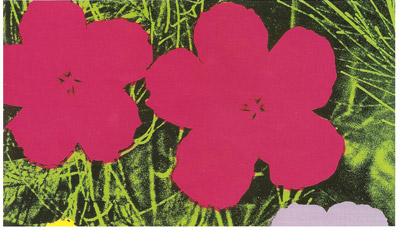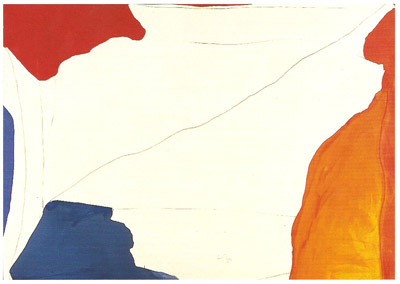Paulina Kolczynska Conversation with Dan McAvoy, Bank of America
(Published Artindex/Gabrius Fall 2002)

Corporate collecting Bank of America
Fine arts specialist Dan McAvoy is Senior Vice-President of the Private Lending Centre of Charlotte North Carolina, which among the other handles the areas with the highest concentration of major collection of major collectors: the Northeast region and Florida.
Paulina Kolczynska: When and why did Bank of America open-art advisory services?
Dan McAvoy: It happened in 1995, when we opened our Private Banking Office in New York. Due to the initiative of a couple of a couple of our senior client managers we decided to implement an art program based on lending money against fine art.
Paulina Kolczynska: Do you offer arts advisory services to pre-existing clients only? What
kind of documentation do your require from your new prospects?
Dan McAvoy: Bank of America's Private Bank focuses on our financing expertise associated with fine art, rather than what might be considered a standard advisory services. You do not have to be pre-existing client to obtain an art secured loan. We would need full financial disclosure from the prospect for the last three years. We’d also run a background investigation, as well as credit bureaus and make our decision on all this information. What we usually prefer is that this individual or entity has a reference from one of our clients, attorney’s office, or accounting firm that we deal with on a regular basis. Most of our referrals usually come from a firm we know or a current client. This is the best type of recommendation.

Andy Warhol
, Flowers (1 of 10 in suite from Flowers portfolio), 1970, screenprint, 28/250. Bank of America Art Collection
Paulina Kolczynska: What are the most popular inquiries?
Dan McAvoy: Probably setting up appraisals and loan structures, because we have many clients who have art in multiple locations both in the US and Europe. We also had clients who have art in galleries or museums, or may wish to consider such an arrangement. We will establish alone for that purpose. The majority of our clients, however, use financing to expand art collections. We need accurate assessment of the value of the collection. We don't appraise in house. We require an appraisal either from a very established dealer well known to the Bank, or
from the major auction houses.
Paulina Kolczynska: What is the minimum value of an artwork for it to be eligible for a loan? And is there a preference as to the type of the artwork?
Dan McAvoy: For us to consider a lone, $100,000 is the minimum value of a single work of art
suitable for collateral. Old Masters paintings and impressionists secure the majority of our loans. To date we have not lent against many contemporary art collections. We do not offer any advice on art as an investment to our clients. However, we do facilitate the appropriate introductions to help our clients sell or purchase art. If our client is just interested in selling or buying some specific artwork, we refer them to either well-established dealers or major auction houses.
Paulina Kolczynska: What kind of documentation do you require for a loan against an artwork?
Dan McAvoy: We have our counsel prepare customized loan documents, security agreements, UCC filings, bills of sale, purchase agreements, and often bailee agreements. The provenance
is something we usually have reviewed by out by our counsel and we make sure that the authenticity is not an issue.
Paulina Kolczynska: Do you offer quick loans and what percentage of the art do you offer as collateral ?
Dan McAvoy: There would not be a problem in offering a quick lona to a well-known client, as long as there is sufficient value in the current collection and we have the appropriate financial information> We usually offer up to 50% advance of the fair market value of the art.
Paulina Kolczynska: What kind of a fee do you charge to manage your collection?
Dan McAvoy: Our fee is based on our overall banking relationship with the clients. It’s
typically 1% of the loan amount. In case of a succession planning need we offer fiduciary services as we are the number one trust provider in the country. In case of sales or purchases weoffer a referral, and we don’t charge a fee for any of our referrals. The referral would be based , of course, on the knowledge of the client’s collection and information about future plans. We don’t collect any commissions from the dealers or auction houses. We expect a favor returned, giving us priority in, for example, a rushed appraisal. We try to build a working relationship with the auction houses and major dealers where we can and get and provide priority treatment if possible.
Paulina Kolczynska: What is the percentage of serious collectors among your clients?
Dan McAvoy: My assessment based on my personal opinion of what I consider a serious individual collector with a significant collection would be approximately 50% of our clients.
The highest concentration is in the northeast region of the United States days and in Florida.
For some reason we don't get as many are related lending requests coming from the west but that is not to say those clients are not serious collectors too. We are just not exposed to them from an-art landing perspective.
Paulina Kolczynska: How many out of these collectors buy art as an investment?
Dan McAvoy: The tendency is now about 50/50. Half of our clients buy for investment, and half for other purposes, including the pure enjoyment of owning the art.
Paulina Kolczynska: Do you see art as an investment?
Dan McAvoy: Certainly. We have many clients who buy art and just keep it in a safe. We have many clients who rotate their art in and out of their homes. It is a unique investment and in my personal opinion there is definitely a market for it. Some clients, however, expect big returns. We also see some clients who are disappointed when they get appraisals performed after not having had one in a while. Some pieces do not appreciate as much as a client might have expected , and some may even lose value.
Paulina Kolczynska: What is the actually figure of collateralized loans for this year?
Dan McAvoy: It’s about $500 million. It has unfortunately decreased in the last several months, as we have a couple of clients who have recently reduced their loans outstanding. Our loan assets secured by fine art are profitable for the Bank.
Paulina Kolczynska: Who is your biggest competitor?
Dan McAvoy: Probably Citibank we feel they’re good competitors. We understand that they have a very good program as well.
Paulina Kolczynska: How do you see the future of art advisory at the Bank of America?

Helen Frankenthaler, Spanning, 1971, acrylic on canvas. Bank of America Art Collection
Dan McAvoy: We will be offering more estate planning and other fiduciary services. We also see the importance of an educational process and marketing of our services. This area will be improved as well. It’s also important to point out that in our line of business we don’t want to be dependent on just art as the primary repayment source for a lending facility.
Paulina Kolczynska: How does a shrinking market for important works of art influence changes in the type of art investment?
Dan McAvoy: Since the market for the older pieces is limited by supply, the market will turn increasingly toward more recent art. In fact, many of our clients are already expanding their collections with contemporary art.
Paulina Kolczynska: Does private banking at the Bank of America sponsor many art-related events?
Dan McAvoy: We are very active in sponsoring art events. It helps us create both new serious fine art clients, as well as bringing in other private banking clients. We do a lot of events in Florida, for example. Overall, my guess, would be that we ‘re involved in such events approximately once a month, inview of the fact that we are in 21 states.
Paulina Kolczynska: What is the structure of the Private Banking office at the Bank of America?
Dan McAvoy: There is the Private Banking Department and the Private Lending Division. I am in the Private Lending Center located in Charlotte, NC, which handles Northeast region, Mid-Atlantic, Carolinas, Georgia and Fin approving and structuring credit requests. The Northeast region team underwrites credit facilities for the New York, New Jersey, Connecticut, as well, the New England area. We have eighteen employees handling this business for that region. Two of them, including myself, are fine art specialists.